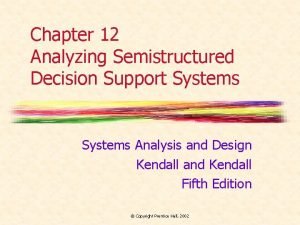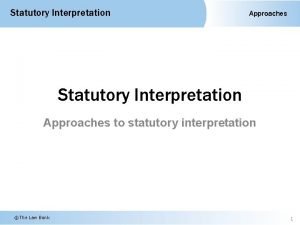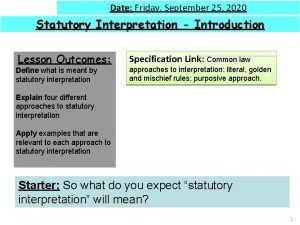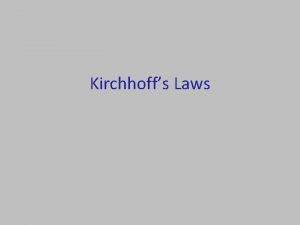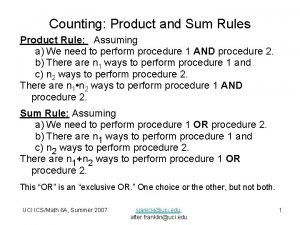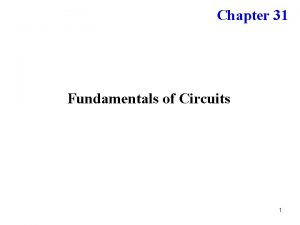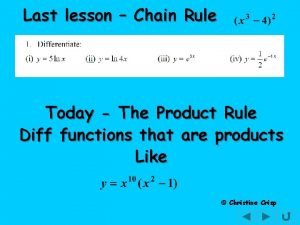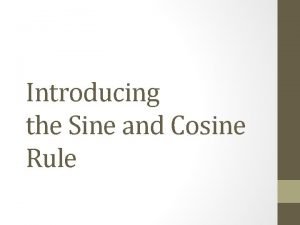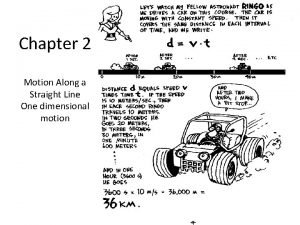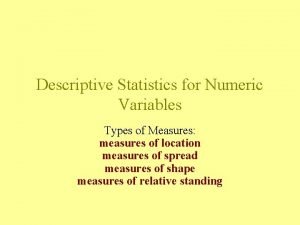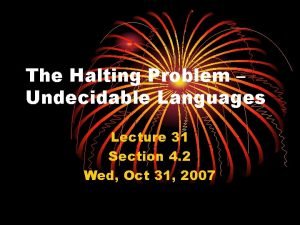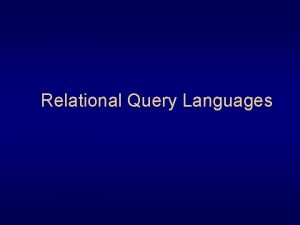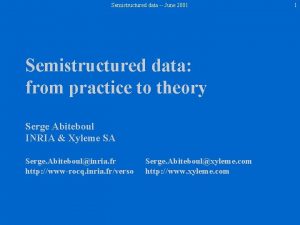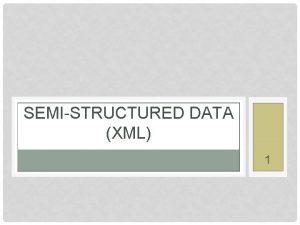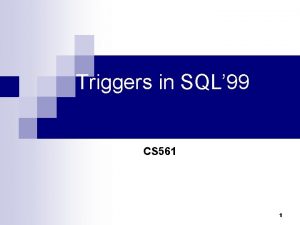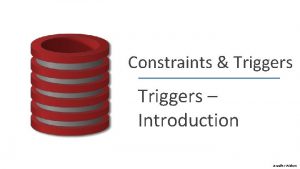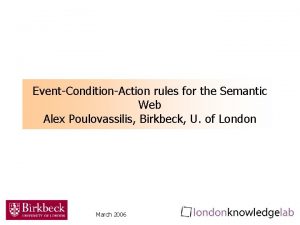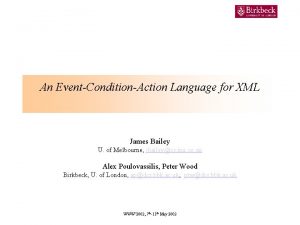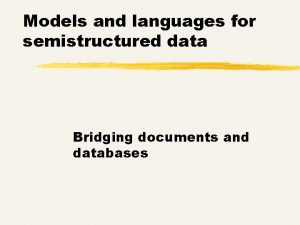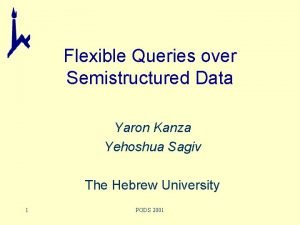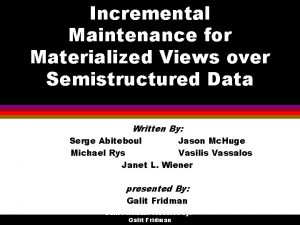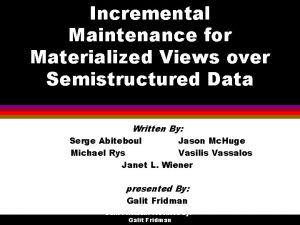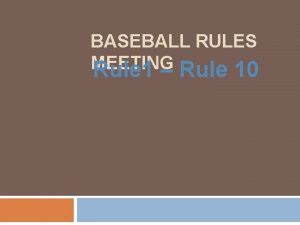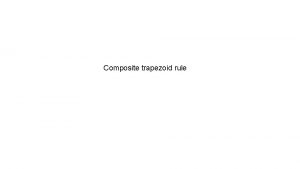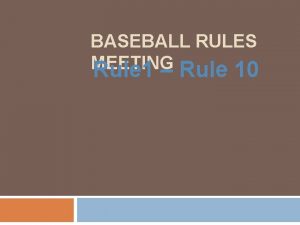EventConditionAction Rule Languages over Semistructured Data George Papamarkos














































- Slides: 46

Event-Condition-Action Rule Languages over Semistructured Data George Papamarkos 13/10/2006

Outline ü What Event-Condition-Action (ECA) Rules are and what we can do with them? ü ECA Rules for XML ü ECA Langugage ü System Architecture ü Performance ü ECA Rules for RDF ü ECA Langugage ü System Architecture ü Performance 13/10/2006 2

What is an ECA Rule? ü An Event-Condition-Action rule performs actions in response to events, given that a stated condition holds ü An event in a database system can be the insertion of a new tuple ü The condition can be a query ü The action may be a relational table update ü This behaviour is called reactive functionality 13/10/2006 3

What is an ECA Rule? ü An ECA rule has the general syntax: on event if condition do action ü The event part specifies when the rule is triggered ü The condition part determines if the data are in a particular state, in which case the rule fires ü The action part describes the actions to be performed if the rule fires. 13/10/2006 4

Advantages of using ECA Rules ü Allow applications reactive functionality to be defined and managed within a single rule base rather than being encoded in the programs ü Use of a high-level declarative syntax and are thus amenable to analysis and optimisation techniques that cannot be applied if the functionality was encoded in the programming code 13/10/2006 5

Outline ü What Event-Condition-Action (ECA) Rules are and what we can do with them? ü ECA Rules for XML ü ECA Language ü System Architecture ü Performance ü ECA Rules for RDF ü ECA Langugage ü System Architecture ü Performance 13/10/2006 6

ECA Rules for XML - Outline üDesign issues of an ECA language for XML üThe XTL Language üImplementing an XTL rules processing system üPerformance Study 13/10/2006 7

Design issues of an ECA language for XML ü Comparing with relational triggers the following are the most important XML-specific issues on designing an ECA language for XML ü Event Granularity: Specifying the granularity of where data has be modified is more complex and requires path expressions ü Action Granularity: Action may affect an entire subdocument meaning that: ü An action can trigger a different set of events ü The analysis of which events are triggered by an action cannot be based on syntax alone 13/10/2006 8

The XTL Language ü The general syntax of XTL rules is: on event if condition do action ü Fragments of XPath and XQuery are used to specify the event, condition and action parts of XTL rules. ü XPath is used for selecting and matching fragments of XML ü XQuery is used withing actions where it is needed to construct a new XML fragment 13/10/2006 9

The XTL Language ü Event Part ü Syntax: (INSERT | DELETE) e where e is an XPath expression evaluating to a set of nodes. ü A rule is triggered if this set of nodes includes any node in the XML fragment inserted or deleted ü The system-defined variable $delta contains this set of nodes and is available for use in condition and action part of the rule 13/10/2006 10

The XTL Language ü Condition Part ü The condition part is either the constant TRUE or one or more XPath expressions connected by the boolean connectives and, or, not. ü Each of these expressions is evaluated on the data to tell whether the condition is TRUE or FALSE 13/10/2006 11

The XTL Language ü Action Part: ü The action part is a sequece of one or more actions ü Syntax: 13/10/2006 ü INSERT r BELOW e (BEFORE | AFTER) q r is an XQuery expression specifying the XML fragment to be inserted, e is an XPath expression specifying the set of nodes under which the new fragment will be inserted, q is either a constant or an XPath qualifier specifying the set of nodes BEFORE or AFTER which the new nodes will be placed. ü DELETE e e is an XPath expression specifing the set of nodes to be deleted. 12

XTL Language ü Example rule: ON INSERT doc(‘s. xml’)/shares/share/dayinfo/prices/price IF $delta > $delta/. . /high DO DELETE $delta/. . /high; INSERT <high>$delta/text()</high> BELOW $delta/. . AFTER prices 13/10/2006 13

XTL rule processing system 13/10/2006 14

XTL rule processing system Architecture ü ECA Rules Management: Validates and registers a rule to the Rule Base ü ECA Rule Processing Engine: ü Evaluates the Event and Condition Parts of the rules and schedules their actions for execution in the Action Schedule 13/10/2006 15

System Performance ü The system performance was studied by: ü Developing an analytical model of the system ü Performing experiments in the actual system ü We have studied the effects of rule base indexes in system performance ü Performance criterion: ü Update response time: The mean time taken to complete all rule execution resulting from a single update submitted by a top-level update transaction 13/10/2006 16

System Performance ü Varying quantities: ü Number of rules in the rule base ü Experiments on the actual performed with three (3) different rule sets ü XML data set: a fragment of DBLP database 13/10/2006 17

System Performance - Analytical Model ü The analytical model is a mathematical description of the system behaviour ü Uses queue theory to simulate the transaction queues and database processing ü Uses a set of simplifying assumptions to emulate the behaviour of some system parameters (e. g. triggering probability, transaction arrival rate etc. ) 13/10/2006 18

System Performance - Analytical Model Results 13/10/2006 19

System Performance - Analytical Model ü Response time increases non-linearly for as long as the system is stable (I. e. arrival rate in the transaction queue is less that the service rate) ü After the stability point the transaction queue grows uncontrollably large, flooding the memory and slowing it down ü Reasons: 13/10/2006 ü Everything served by a single queue ü High number of event query evaluations to find what is triggered 20

System Performance Experimental Results 13/10/2006 21

System Performance Experimental Results ü Difference with Analytical Model due to: ü implementation choices (use of DOM etc. ) and ü the simplification assumptions made in the analytical model 13/10/2006 22

System Performance 13/10/2006 23

System Performance - Indexing Rule Base 13/10/2006 24

System Performance - Indexing Rule Base ü Better overall behaviour and scalability characteristics due to smaller number of rules that need to be checked for triggering ü Smaller number of rules checked --> smaller number of queries need to be evaluated 13/10/2006 25

Outline ü What Event-Condition-Action (ECA) Rules are and what we can do with them? ü ECA Rules for XML ü ECA Langugage ü System Architecture ü Performance ü ECA Rules for RDF ü ECA ü Performance Langugage ü System Architecture 13/10/2006 26

ECA Rules for RDF ü The RDFTL ECA Language ü Implementing RDFTL processing system in P 2 P environments ü System performance 13/10/2006 27

The RDFTL Language ü We have designed the language from scratch specifically for RDF ü General Syntax: ü ON event IF condition DO action 13/10/2006 28

The RDFTL Language ü Event Part: 13/10/2006 ü May contain let expressions of the form: LET $var : = e ü (INSERT | DELETE) e e is a path expression that evaluates on a set of RDF nodes. Catches the insertion or deletion of a node ü (INSERT | DELETE) triple is an expression of the form (source, arc, target) specifying an RDF triple. Catches the insertion or deletion of a property in an RDF triple. ü UPDATE upd_triple is an expression of the form (source, arc, old_target->new_target). Catches the update of a 29 property from one RDF node to another.

The RDFTL Language ü Condition Part: ü It is a boolean-valued expression ü May consist of conjunctions, disjunctions and negations ü May also contain let expressions ü The $delta variable bound to the set of nodes or arcs modified and caught by the event part ü Action Part: ü A sequence of actions ü Each action has similar syntax with the event part 13/10/2006 30

RDFTL Rules in P 2 P Environments System Architecture 13/10/2006 31

RDFTL Rules in P 2 P Environments ü Each peer (P) is supervised by a superpeer (SP) ü The set of Ps supervised by an SP form a peergroup ü At each SP there is an RDFTL processing engine installed ü Each P or SP hosts a fragment of the RDF schema that may change due to updates ü Hybrid fragmentation with possible replication 13/10/2006 32

RDFTL Rules in P 2 P Environments ü Ps notify the SPs for any updates on their local data ü An ECA rule generated at one P or SP may be replicated, triggered, evaluated or executed in different sites in the net. 13/10/2006 33

Distributed Rule Registration ü A rule generated is sent from P to SP for validation and storage ü From there it is sent to all other SPs ü A replica of it will be stored also to those SPs that are e-relevant to the rule. I. e. the event part queries of a rule can be evaluated on SP ü At each SP each rule is annotated with IDs of local peers that are e-, c- and a-relevant to the rule ü c- and a- relevance have a similar meaning with erelevance for the condition and action part 13/10/2006 34

Distributed Rule Execution ü Each SP manages its own rule execution schedule ü Each execution schedule is a sequence of updates to be executed on the local peergroup ü Once an update u occurs in P, SP is notified ü SP determines if u may trigger any rule whose event part is annotated with P’s ID. ü If yes, the event query is sent to P for evaluation ü If the rule is triggered, its condition will be evaluated ü If the condition is true SP will send each instance of r’s action part to local peers that are a-relevant to it 13/10/2006 35

System Performance ü The system performance was studied by: ü Developing an analytical model of the system ü Developing a system simulator and performing experiments with it ü Performance criterion: ü Update response time: The mean time taken to complete all rule execution resulting from a single update submitted by a top-level update transaction 13/10/2006 36

System Performance ü Cases studied with both the Analytical Model and the Simulator : ü Random Network topology between SPs, with various data replication degree ü Hyper. Cup Network topology between SPs, with various data replication degree ü Varying quantities: ü Number of peergroups ü Number of rules 13/10/2006 37

System Performance Random topology - Replication 10% Analytical Model 13/10/2006 Simulation 38

System Performance ü With random topology system does not scale well even with low replication and number of rules and peergroups ü Exponential update response time ü System becomes unusable due to high load 13/10/2006 39

System Performance ü Hyper. Cup organises the SPs into hypercubes ü Hyper. Cup topology guarantees that: ü Each peer receives a message only once ü A total number of N-1 hops is necessary to broadcast a message to N peers ü The more distant peers are reached after log 2 N hops 13/10/2006 40

System Performance Hyper. Cup - Replication 10% Analytical Model 13/10/2006 Simulation 41

System Performance Hyper. Cup - Replication 90% Analytical Model 13/10/2006 Simulation 42

System Performance ü With Hyper. Cup we achieve higher performance for various replication levels and number of peergroups ü System scales better ü System remains stable and the update response time within acceptable values ü Analytical with simulation approach show good agreement 13/10/2006 43

Conclusions ü We have described two ECA languages for XML and RDF ü We have studied and defined the architectural characteristics for an ECA rule processing system in centralised and distributed environment ü We have conducted a study to determine the system performance in both the centralised and distributed case 13/10/2006 44

Conclusions ü The whole study shows that ECA rules is a usable technology for various different application environments over semistructured data 13/10/2006 45

Thank you !! 13/10/2006 46
 Semistructured decision
Semistructured decision What was the pundit's mother tongue
What was the pundit's mother tongue Differences between george washington and king george iii
Differences between george washington and king george iii Venn diagram george washington and king george iii
Venn diagram george washington and king george iii Hive
Hive Over the mountains over the plains
Over the mountains over the plains Siach reciting the word over and over
Siach reciting the word over and over Handing over and taking over the watch
Handing over and taking over the watch List the primitives that specify a data mining task.
List the primitives that specify a data mining task. Data mining languages and system architecture
Data mining languages and system architecture Whitely v chappel
Whitely v chappel Adler v george golden rule
Adler v george golden rule Obey them that have rule over you
Obey them that have rule over you Magic triangles trigonometry
Magic triangles trigonometry Cose rule
Cose rule Sohcahtoa rule
Sohcahtoa rule Kirchoff's junction rule
Kirchoff's junction rule Sum and product rule
Sum and product rule Home rule vs dillon's rule
Home rule vs dillon's rule Kirchhoff's loop law equation
Kirchhoff's loop law equation Bioblique astigmatism
Bioblique astigmatism With the rule astigmatism
With the rule astigmatism Against the rule astigmatism
Against the rule astigmatism What is the cold chain rule
What is the cold chain rule Chain rule範例
Chain rule範例 Sine rule cosine rule
Sine rule cosine rule Chain rule power rule
Chain rule power rule Tukey's rule vs empirical rule
Tukey's rule vs empirical rule Wired and wireless media
Wired and wireless media Data exfiltration over dns
Data exfiltration over dns Why do languages vary among places
Why do languages vary among places Assembly language list
Assembly language list Multithreaded languages
Multithreaded languages Turing unrecognizable languages
Turing unrecognizable languages Love language results
Love language results 5 love languages test
5 love languages test Pintrest
Pintrest Love languages chart
Love languages chart 11 official languages of south africa
11 official languages of south africa How many languages are there
How many languages are there Ror programming language
Ror programming language What languages come from latin
What languages come from latin Relational query languages in dbms
Relational query languages in dbms Real-time systems and programming languages
Real-time systems and programming languages Language
Language Cs 421
Cs 421 Multithreading program in java
Multithreading program in java
